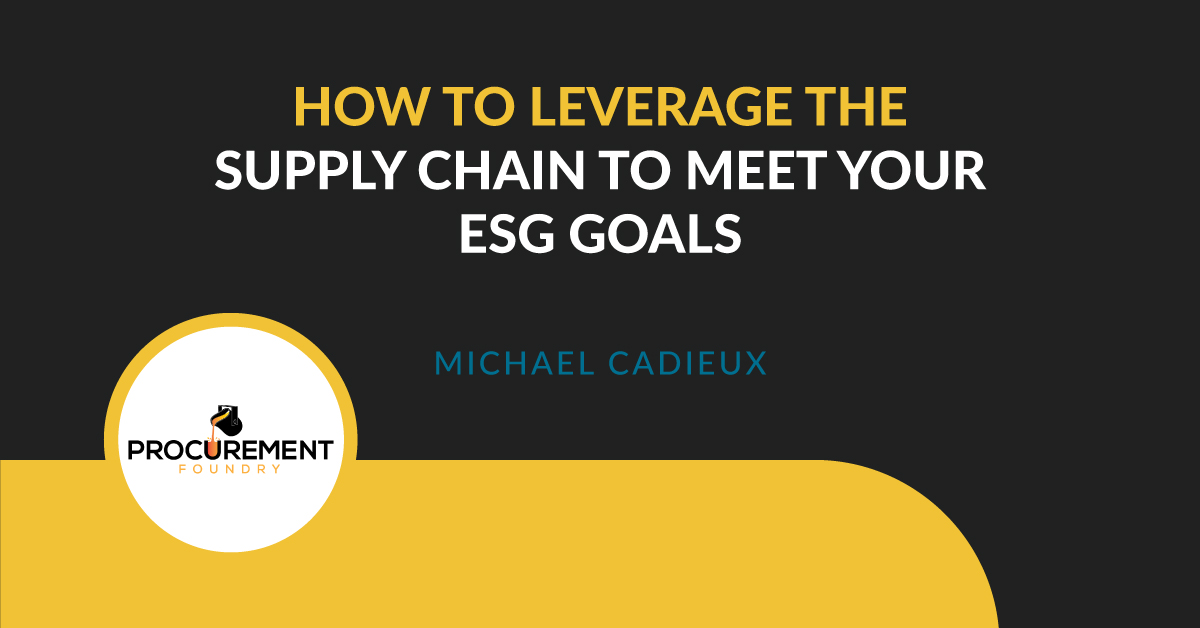Maximizing Savings Opportunities and Procurement's Strategic Value for CPOs
Saving money is not always about pinching pennies: advanced and data-driven insights enable you to identify real cost-saving opportunities, negotiate...
3 min read
![]() Michael Cadieux
:
7/11/22 9:00 AM
Michael Cadieux
:
7/11/22 9:00 AM

If someone on the street asked you if you would like to do better at reaching ESG goals (such as protecting and conserving our environment), I think you would be hard-pressed to find someone to say no. Of course, we want these things!
But, if asked by that same person in a follow-up question what we are actively doing (or willing to do) to make this want a reality, the response might be an awkward silence for many. Those in procurement know that many of us are constantly looking for solutions to environmental supply chain issues but seem to get stuck on where to begin and how to follow through.
So, I wanted to walk through this starting from step one: You have to make your ESG goals with clear targets to shoot for and quantifiable measures for success. But first, let’s define what supply chain ESG goals are.
When it comes to Supply Chain ESG goals (ESG is an acronym for Environmental, Social, and Governance), supply chain sourcing and management strategies are taking center stage.
The constant changes in the regulatory environment, not to mention the heightened pressure from consumers and shareholders, are creating increasing demand for ESG goals to become top priorities for businesses. Here’s where the supply chain comes in, as the foundation for attaining both profit and purpose (the ultimate ESG goal) requires perfect harmony and alignment between procurement and supply chain teams.
Examples of some excellent supply chain ESG goals would include measures involved with improving transportation (lowering emissions and cost of moving goods, etc.), manufacturing (reducing wastes and costs), social responsibility and governance, and more. Ethical labor practices, diversity and inclusion, and environmental protection are also of top priority. Getting visibility into sub-tier suppliers to monitor these things is a tricky and frustrating task.
Why should you care? Besides the obvious save the world reason (which is more than valid), ESG is good for business. And the numbers prove it.
According to a report by McKinsey and Company, an estimated global sustainable investment tops the $30 trillion mark. This is a dramatic and telling uptick from previous years and contributes to the increasing attention society, the government, and consumers place on the impact of corporations. Attaining ESG goals has a positive effect on a company’s long-term success as well as its brand. And the raised awareness of this only adds to investors’ eagerness to sign on to ESG initiatives.
According to Niall FitzGerald, Former CEO of Unilever, “Corporate social responsibility is a hard-edged business decision. Not because it is a nice thing to do or because people are forcing us to do it ... but because it is good for our business.”
So, we now know what supply chain ESG goals are and can see why ESG takes top priority on a company’s vision for the future, but the question remains: What do corporate sustainability goals look like in practice?
As mentioned briefly above, the main areas your supply chain ESG goals should focus on include:
To set these goals in quantifiable modes, I suggest taking these four simple steps:
This initial step lays the foundation for your entire ESG endeavor. Here is where you and your company must sharpen what’s important—ask yourselves what you are really aiming to achieve.
But you can’t set anything as a goal. Instead, you must distill your goals into actionable (and measurable) performance indicators. Remember KPIs? This is where they come into play, helping you target and measure specific supply chain issues that will affect your overall success and how you get there.
Speaking of KPIs, as you are defining success in these areas, it will require using quantitative metrics-linked goals with hard numbers and data to confirm when and if you have reached your target. After all, you need something to shoot for, but you also need to identify how to know if you’ve hit your mark.
This one is easy to explain. Once you’ve established your goals and how you’ll measure when and if you reach them, this step involves laying out a specific plan for getting there. Simply put, your strategy details which specific actions you’ll take to reach your ESG goals.
You have firmly established your ESG goals in steps 1–2, then followed that up by developing a clear, proactive strategy for achieving those targets. Now is the time to gather your information and impress your investors with your ideas, garnering enough excitement for them to back you. If your plan is solid, securing buy-in on ESG should be easy.
Once you have completed these four steps and refined what you plan to achieve, enlisting the aid of your supply chain partners will be invaluable to your success. For instance, gathering data from your supply chain partners can help you in many ways, including establishing and measuring your success in further ESG goals.
Data is a priceless currency, as its risk management value alone is astronomical. Data helps you more easily identify and manage potential risks across your entire ecosystem and helps to establish—and ensure compliance with—your core ESG initiatives across your entire network. Getting everyone on board and working together is a win-win for all.
Want to learn more? Join us for our next conference, Procurement Foundry’s FORGE: People, Planet, Profit & Procurement event.

Saving money is not always about pinching pennies: advanced and data-driven insights enable you to identify real cost-saving opportunities, negotiate...

The topic of our recent roundtable discussion with a dozen Procurement Foundry community members—exploring potential flaws in procurement incentive...

Every 30 days or so, I get the same alert on my phone—“Your electricity bill is available for viewing.” I take a quick look, make sure nothing seems...